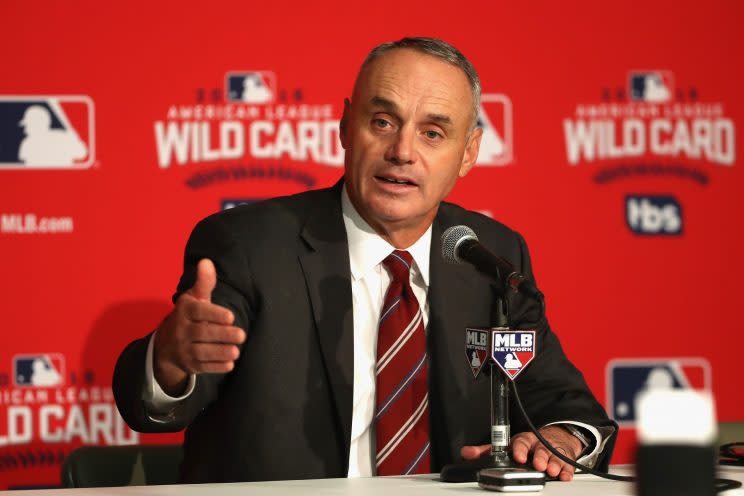Rob Manfred remains focused on pace of play, but will improvements come?

After taking office on Jan. 25, 2015, MLB commissioner Rob Manfred made improving the pace of play one of his top priorities.
Two years later, not a lot has changed in that regard.
[Sign up for Yahoo Fantasy Baseball | 2017 Player Rankings]
At the quarterly owners’ meetings in Palm Beach, Fla. on Friday, Manfred again made pace of play a primary focus while reiterating its importance and reinforcing his commitment to making improvements a reality.
“That’s an issue that we need to be focused on. And the ‘we’ there is players, owners, umpires — everyone who is invested in this game,” Manfred told the gathered media at The Breakers resort.
“It’s going to be an ongoing process. I don’t think there’s a magic bullet that is going to come one year and that’s going to be the solution to pace of play. It’s going to be an ongoing effort to make sure our game moves along in the way that is most attractive to our fans.”
Despite reinforced rules and experiments all aimed toward achieving that goal, the league has struggled to sustain a pace that’s satisfying to Manfred or what he would term “appealing” to fans, who are ultimately the most important judges.
The idea is not necessarily to shorten games time wise. There are just too many factors in a given game to make that a consistent reality. Beyond that, part of baseball’s charm is that there is no time limit. That every game has its own flow and tells a story that is rarely entirely duplicated.
But the average time of games can be telling too, and right now they are not indicating much forward movement. The average length of games has only dropped two minutes in two seasons under Manfred. It’s something, sure, but those numbers aren’t as encouraging as they might seem. While the average time of games decreased six minutes from 2014 to 2015, it actually increased four minutes from 2015 to 2016.
What Manfred can and will continue focusing on is eliminating as much downtime as possible, which means time between innings, between pitches, during mound visits and pitching changes. If there’s a lot of action, that’s great. If the time between the action significantly outweighs the action itself, that’s a problem. That’s when Manfred believes fans start tuning out.
[Newsletter: Get 5 great stories from the Yahoo Sports blogs in your inbox every morning!]
Some of this might feel like recycled information and quotes. Much of it truly is. But it felt like Manfred was a little more optimistic when he noted that the new Collective Bargaining Agreement contains a provision that would allow playing-rule changes geared toward quickening the pace.
“We did review some rule changes largely related to pace of game that are being discussed with the players’ association,” Manfred said. “More to follow when those negotiations are complete.”
That means anything from pitch clocks to limiting warm up pitches to anchoring batters in the batters’ box could be on the negotiating table.
What will be interesting to see is whether or not the MLBPA and the players themselves share the same urgency when it comes to pace of play. We can’t imagine they enjoy nine inning games lasting well over four hours, but we also can’t imagine them ever agreeing to completely change their routine for the sake of saving time.
Those possibilities could leave baseball stuck in the mud, at least through Manfred’s eyes.
More MLB coverage from Yahoo Sports:
– – – – – – –
Mark Townsend is a writer for Big League Stew on Yahoo Sports. Have a tip? Email him at bigleaguestew@yahoo.com or follow him on Twitter!



